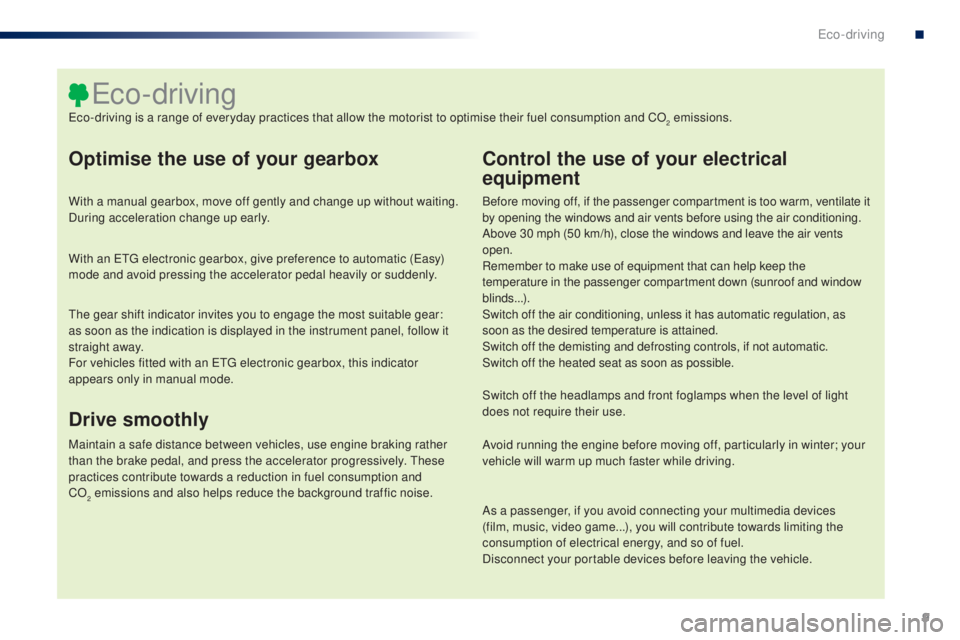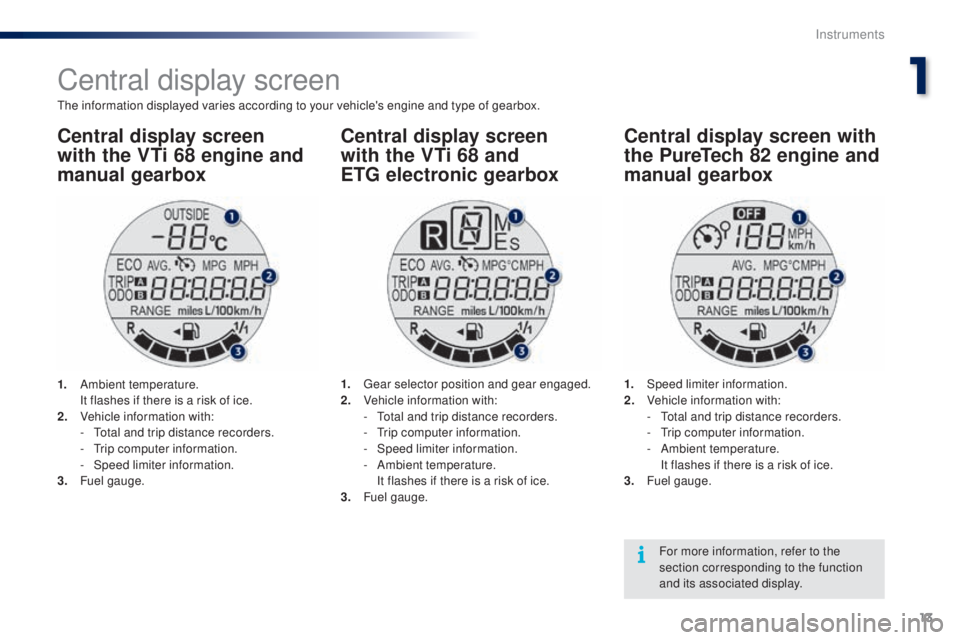Page 4 of 268

.
.
108_en_Chap00a_sommaire_ed01-2016
Instrument panels 11
Display screens
1
3
Indicator and warning lamps
1
5
Indicators
26
tr
ip computer
2
7
Setting the time
2
9
InstrumentsOver view
Keys
31
Keyless e
n
try and Starting system
3
4
Doors
38
Boot
39
Front electric windows
4
1
Rear quarter windows
4
1
ele
ctric fabric roof
4
2
Access
Front seats 4 6
Rear seats
4
8
Mirrors
50
Steering wheel adjustment
5
1
Ventilation
52
Heating
54
Manual air conditioning
5
5
Automatic air conditioning
5
7
Front demist - defrost
6
0
Rear screen demist - defrost
6
1
Courtesy lamp
6
2
Boot lamp
6
2
Interior fittings
6
3
Rear parcel shelf
6
7
Boot fittings
6
8
ease of use and comfort
Driving recommendations 70
Starting - switching off the engine
with the key
7
1
Starting - switching off the engine with
the
Keyless e
n
try and Starting system
7
2
Manual parking brake
7
6
5-speed manual gearbox
7
6
e
tg
el
ectronic gearbox
7
7
ge
ar shift indicator
8
1
Hill start assist
8
2
Stop & Start
8
3
Speed limiter
8
6
Reversing camera
9
2
Lane departure warning system
9
3
Under-inflation detection
9
5
Driving
e
co-driving
Contents
Page 11 of 268

9
108_en_Chap00c_eco-conduite_ed01-2016
optimise the use of your gearbox
With a manual gearbox, move off gently and change up without waiting.
During acceleration change up early.
With an etg electronic gearbox, give preference to automatic (
ea
sy)
mode and avoid pressing the accelerator pedal heavily or suddenly.
Control the use of your electrical
equipment
Before moving off, if the passenger compartment is too warm, ventilate it
by opening the windows and air vents before using the air conditioning.
Above 30 mph (50 km/h), close the windows and leave the air vents
open.
Remember to make use of equipment that can help keep the
temperature in the passenger compartment down (sunroof and window
blinds...).
Switch off the air conditioning, unless it has automatic regulation, as
soon as the desired temperature is attained.
Switch off the demisting and defrosting controls, if not automatic.
Switch off the heated seat as soon as possible.
Switch off the headlamps and front foglamps when the level of light
does not require their use.
Avoid running the engine before moving off, particularly in winter; your
vehicle will warm up much faster while driving.
As a passenger, if you avoid connecting your multimedia devices
(film, music, video game...), you will contribute towards limiting the
consumption of electrical energy, and so of fuel.
Disconnect your portable devices before leaving the vehicle.
eco-driving
eco-driving is a range of everyday practices that allow the motorist to optimise their fuel consumption and CO2 emissions.
th
e gear shift indicator invites you to engage the most suitable gear:
as soon as the indication is displayed in the instrument panel, follow it
straight away.
For vehicles fitted with an
etg
electronic gearbox, this indicator
appears only in manual mode.
Drive smoothly
Maintain a safe distance between vehicles, use engine braking rather
than the brake pedal, and press the accelerator progressively. th ese
practices contribute towards a reduction in fuel consumption and
CO
2 emissions and also helps reduce the background traffic noise.
.
eco-driving
Page 13 of 268
11
108 _en_Chap01_instrument- de-bord_ed01-2016
Instrument panels
type 1 instrument panel
1. Speedometer (mph or km/h).
2. Central display screen.
F
or more information, refer to the
corresponding section.
3.
g
e
ar shift indicator. 4. D
isplay management button (DISP). D
isplay of information in ascending order.
5.
D
isplay management button (DISP).
D
isplay of information in descending order.
1
Instruments
Page 14 of 268
12
1. Speedometer (mph or km/h).
2. Central display screen.
F
or more information, refer to the
corresponding section.
3.
g
e
ar shift indicator.
4.
D
isplay management button (DISP).
D
isplay of information in ascending order.
type 2 instrument panel
5. Display management button (DISP). D isplay of information in descending order.
6.
R
ev counter
t
h
e engine speed is indicated by the
display of orange illuminated bars.
A
bove the maximum engine speed, the
bars are displayed in red to warn you of the
need to change up.
Instruments
Page 15 of 268

13
108 _en_Chap01_instrument- de-bord_ed01-2016
Central display screen
the information displayed varies according to your vehicle's engine and type of gearbox.
Central display screen
with the V
ti
68 engine and
manual gearbox Central display screen
with the V
ti
68 and
et
g electronic gearboxCentral display screen with
the Pure
te
ch 82 engine and
manual gearbox
1. Ambient temperature. I
t flashes if there is a risk of ice.
2.
V
ehicle information with:
-
t
o
tal and trip distance recorders.
-
t
r
ip computer information.
-
S
peed limiter information.
3.
F
uel gauge. 1.
gea r selector position and gear engaged.
2. V ehicle information with:
-
t
o
tal and trip distance recorders.
-
t
r
ip computer information.
-
S
peed limiter information.
-
A
mbient temperature.
I
t flashes if there is a risk of ice.
3.
F
uel gauge.1. S
peed limiter information.
2. V ehicle information with:
-
t
o
tal and trip distance recorders.
-
t
r
ip computer information.
-
A
mbient temperature.
I
t flashes if there is a risk of ice.
3.
F
uel gauge.For more information, refer to the
section corresponding to the function
and its associated display.
1
Instruments
Page 16 of 268
14
Seat belts and passenger's
front airbag warning lamps
display screen
A. Left hand rear seat belt unfastened warning.
B.
R
ight hand rear seat belt unfastened
warning.
C.
P
assenger's front airbag deactivated
warning lamp.
D.
P
assenger's front airbag activated warning
lamp.
Warning lamp C or D remains on,
depending on the state of the passenger's
front airbag (deactivated or activated).
Instruments
Page 24 of 268

22
Parking brakefixed, accompanied by
an audible signal.th e parking brake is applied or not
properly released. Release the parking brake to switch off the warning
lamp, keeping your foot on the brake pedal.
Observe the safety recommendations.
For more information on the parking brake, refer to the
corresponding section.
Warning / indicator lamp
StateCause Action / o
b
servations
Passenger's
front airbag fixed in the seat belt
and passenger's front
airbag warning lamps
display.
th
e control switch, located in the
glove box, has been placed in the
"
o
N
" position.
the
passenger's front airbag is activated.
In this case, do not install a rear ward facing child seat.
Stop & Star t
(V
ti 6
8 S&S
engine) fixed.
When the vehicle stops (red lights,
traffic jams...) the Stop & Start system
has put the engine into S
tO
P mode.
th
e indicator lamp goes off and the engine restarts
automatically in S
tA
R
t
mode, as soon as you want to
move off.
Keyless
e
n
tr y
and Starting
system fixed.
th
e conditions for starting are met. For more information, refer to the "Starting - switching off the engine with the Keyless
e
n
try and Starting
system" section.
flashing slowly.
th
e vehicle is in "ACC" mode.
th
e accessories (audio system,
12V socket...) can be used.
Instruments
Page 26 of 268

24
Passenger's
front airbagfixed, in the seat belt
and front passenger's
airbag warning lamps
display.th
e control switch, located in the
glove box, is set to the oFF p
osition.the passenger's front airbag is deactivated.
You can install a "rear ward facing" child seat on the
front seat unless there is a fault with the airbags
(Airbag warning lamp on).
tr
action control
(
tR
C) fixed.
A brief press has been made on the
button.
th
e traction control (
tR
C) system is
deactivated. Press the button to activate the system.
th
e t
R
C system is activated automatically when the
vehicle is started.
If deactivated, the system is reactivated automatically
from around 30 mph (50 km/h).
For more information, refer to the corresponding
section.
Dynamic
stability control
(DSC) fixed.
Vehicle stationary, the button
has been pressed for more than
3
seconds.
th
e traction control (
tR
C) and
dynamic stability control (DSC)
systems are deactivated. Press this button to activate the systems.
th
e DSC system is activated automatically when the
vehicle is started.
For more information, refer to the corresponding
section.
Warning / indicator lamp
StateCause Action / o
b
servations
Deactivation indicator lamps
If one of the following indicator lamps comes on, this confirms that the corresponding system has been switched off intentionally.th
is is may be accompanied by an audible signal.
Instruments